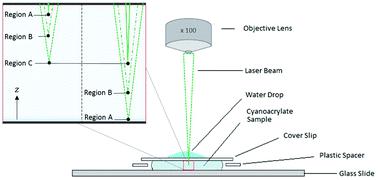当前位置:
X-MOL 学术
›
Phys. Chem. Chem. Phys.
›
论文详情
Our official English website, www.x-mol.net, welcomes your feedback! (Note: you will need to create a separate account there.)
Use of confocal Raman microscopy to characterise ethyl cyanoacrylate adhesive depth curing
Physical Chemistry Chemical Physics ( IF 3.3 ) Pub Date : 2020-10-07 , DOI: 10.1039/d0cp04053c Kevin Raheem 1, 2, 3, 4, 5 , John Cassidy 1, 2, 3, 4, 5 , Anthony Betts 1, 2, 3, 4, 5 , Bernard Ryan 6, 7, 8, 9, 10
Physical Chemistry Chemical Physics ( IF 3.3 ) Pub Date : 2020-10-07 , DOI: 10.1039/d0cp04053c Kevin Raheem 1, 2, 3, 4, 5 , John Cassidy 1, 2, 3, 4, 5 , Anthony Betts 1, 2, 3, 4, 5 , Bernard Ryan 6, 7, 8, 9, 10
Affiliation

|
In situ spatial temporal measurement of monomer conversion during adhesive bondline curing remains a challenging area. The aim of this work was to demonstrate the effectiveness of using confocal Raman microscopy in a specially configured experimental set-up, as a versatile tool for measuring monomer concentration changes as a function of both time and adhesive bond depth during ethyl cyanoacrylate polymerisation. This also allowed monitoring of the extent of polymerisation at the adhesive substrate interface independently of the bulk bondline polymerisation region. Key kinetic parameters such as inhibition time tlag, rate of reaction Rmax and extent of reaction [αt]max were obtained by fitting the experimental data to sigmoidal growth curves using simple piecewise regression models. A systematic characterisation of a polymerisation reaction was conducted using different sample substrate types (copper alloy (red brass), aluminium, aluminium alloy, stainless steel and borosilicate glass) and at various reaction temperatures. Reaction rates were found to decrease further away from the substrate interface in the bulk volume region. The fastest kinetics occurred in the vicinity of nucleophilic hydroxyl rich surfaces such as at the copper alloy (red brass). In addition to substrate surface chemistry, surface roughness was also a factor, with the highest reaction rates occurring with a grit blasted (roughened) aluminium alloy (2024 T3) surface. An approximately linear dependence of the ln Rmax vs. 1/T (Arrhenius) plot was recorded within the temperature range of 291–328 K. A better fit was obtained however through the use of two separate linear slopes, possibly indicative of a change of polymerisation reaction mechanism taking place at elevated temperatures with two distinct activation energies. Further work conducted using a larger number of temperatures would be useful to verify this finding. This work confirmed that differences in the rates of interfacial and bulk polymerisation processes could be readily measured in situ using confocal Raman microscopy which is a powerful technique for investigating such surface-confined and bulk polymerisation reactions.
中文翻译:

使用共聚焦拉曼显微镜表征氰基丙烯酸乙酯粘合剂的深度固化
在粘合剂粘结线固化过程中对单体转化率进行原位时空测量仍然是一个充满挑战的领域。这项工作的目的是证明在特殊配置的实验装置中使用共焦拉曼显微镜的有效性,这是一种用于测量氰基丙烯酸乙酯聚合过程中单体浓度随时间和粘合剂深度变化的函数的通用工具。这还允许独立于本体键合线聚合区域来监视在粘合剂基底界面处的聚合程度。键动力学参数如抑制时间吨滞后,反应的速率- [R最大和反应的程度[ α吨]最大通过使用简单的分段回归模型将实验数据拟合到S形增长曲线中获得。使用不同的样品基材类型(铜合金(红色黄铜),铝,铝合金,不锈钢和硼硅酸盐玻璃)在各种反应温度下进行了聚合反应的系统表征。发现反应速率在整个体积区域中远离基底界面进一步降低。最快的动力学发生在亲核羟基富集表面附近,例如铜合金(红色黄铜)处。除基材表面化学性质外,表面粗糙度也是一个因素,其中喷砂处理(粗糙)的铝合金(2024 T3)表面的反应速率最高。ln R的近似线性相关性 最大 VS。在291–328 K的温度范围内记录了1 / T(阿累尼厄斯)图。但是,通过使用两个单独的线性斜率可以获得更好的拟合,这可能表明在高温下,两个反应温度发生了聚合反应机理的变化。独特的活化能。使用大量温度进行的进一步工作将有助于验证这一发现。这项工作证实了使用共聚焦拉曼显微镜可以很容易地就地测量界面和本体聚合反应速率的差异,这是研究这种表面受限和本体聚合反应的有力技术。
更新日期:2020-10-19
中文翻译:

使用共聚焦拉曼显微镜表征氰基丙烯酸乙酯粘合剂的深度固化
在粘合剂粘结线固化过程中对单体转化率进行原位时空测量仍然是一个充满挑战的领域。这项工作的目的是证明在特殊配置的实验装置中使用共焦拉曼显微镜的有效性,这是一种用于测量氰基丙烯酸乙酯聚合过程中单体浓度随时间和粘合剂深度变化的函数的通用工具。这还允许独立于本体键合线聚合区域来监视在粘合剂基底界面处的聚合程度。键动力学参数如抑制时间吨滞后,反应的速率- [R最大和反应的程度[ α吨]最大通过使用简单的分段回归模型将实验数据拟合到S形增长曲线中获得。使用不同的样品基材类型(铜合金(红色黄铜),铝,铝合金,不锈钢和硼硅酸盐玻璃)在各种反应温度下进行了聚合反应的系统表征。发现反应速率在整个体积区域中远离基底界面进一步降低。最快的动力学发生在亲核羟基富集表面附近,例如铜合金(红色黄铜)处。除基材表面化学性质外,表面粗糙度也是一个因素,其中喷砂处理(粗糙)的铝合金(2024 T3)表面的反应速率最高。ln R的近似线性相关性 最大 VS。在291–328 K的温度范围内记录了1 / T(阿累尼厄斯)图。但是,通过使用两个单独的线性斜率可以获得更好的拟合,这可能表明在高温下,两个反应温度发生了聚合反应机理的变化。独特的活化能。使用大量温度进行的进一步工作将有助于验证这一发现。这项工作证实了使用共聚焦拉曼显微镜可以很容易地就地测量界面和本体聚合反应速率的差异,这是研究这种表面受限和本体聚合反应的有力技术。



























 京公网安备 11010802027423号
京公网安备 11010802027423号